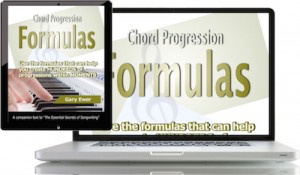There are some genres that are edgy and energetic by nature. If you like the warm fuzzy feeling you get from a lightly-accompanied ballad, you’re not likely going to be writing heavy metal.
But what if you like lightly-accompanied music for the transparency of its sound, but you wish your song had a bit more edge? In other words, what can you do to limit the “sweetness factor” of your songwriting?
 If all you really need are some chord progressions to get your songwriting process started, check out “Essential Chord Progressions” and “More Essential Chord Progressions.” Tons of chords for any genre, playing style, or tempo. They’re part of “The Essential Secrets of Songwriting” 10-eBook Bundle. Get today’s FREE DEAL: a copy of “Creative Chord Progressions”
If all you really need are some chord progressions to get your songwriting process started, check out “Essential Chord Progressions” and “More Essential Chord Progressions.” Tons of chords for any genre, playing style, or tempo. They’re part of “The Essential Secrets of Songwriting” 10-eBook Bundle. Get today’s FREE DEAL: a copy of “Creative Chord Progressions”
What we call sweetness is largely dictated by musical expectations. We just happen to know, for example, that adding lush strings to an instrumentation is going to make music sound sweet. But what else can you do to tone down the sweetness factor, and allow a little more edge through?
A good producer can do much to help tone down the sweetness factor of your song once it gets to the recording stage. But before you get into the studio, think about the following things that you as a songwriter can do to manipulate the overall sound and mood of your music:
- Choose chord progressions that avoid the V- or V7-chord. These chords are highly predictable in the way they work, and replacing them with either a bVII will give you an edgier sound. (Be sure to check the melody note of the moment to make sure that it works with whatever you sub in as your new chord.
- Avoid diminished chords. There’s something about diminished chords (C#-E-G) and diminished-7th chords (C#-E-G-Bb) that considerably warm up the fuzzy-factor in music. They’re lovely chords, but it might be best to avoid them.
- Increase tempo and/or raise the key. A faster tempo and higher key go hand-in-hand with a rise in musical energy, and so sometimes that’s all that’s needed to give music a more vibrant, powerful sound.
- Reduce the general melodic shape. Ballads often use melodic leaps (both ascending and descending) as a way of creating an emotional response in the listener, what you might call the “Somewhere Over the Rainbow” effect. Writing song melodies that keep coming back to the same note over and over has a way of creating a more insistent, cooler sound. Example: “Ohio” (Neil Young, recorded by Crosby, Stills, Nash & Young).
- Avoid forced rhymes and other predictable lyrical devices. A forced rhyme becomes evident when you feel that a line’s most important purpose is to match the one that came before it. Go for an approximate rhyme over an exact one, to get the message of your lyric right. And also consider the possibility of a non-rhyming lyric.
 Written by Gary Ewer. Follow Gary on Twitter.
Written by Gary Ewer. Follow Gary on Twitter.
 If you want a quick way to create chord progressions that make sense, you need “Chord Progression Formulas.” This eBook manual shows you how to take some basic formulas, and create dozens of progressions in moments. It’s part of “The Essential Secrets of Songwriting” 10-eBook Bundle.
If you want a quick way to create chord progressions that make sense, you need “Chord Progression Formulas.” This eBook manual shows you how to take some basic formulas, and create dozens of progressions in moments. It’s part of “The Essential Secrets of Songwriting” 10-eBook Bundle.











Pingback: Toning Down the “Sweetness” Factor In Your Songs - The Hit Songwriting Formula | The Hit Songwriting Formula